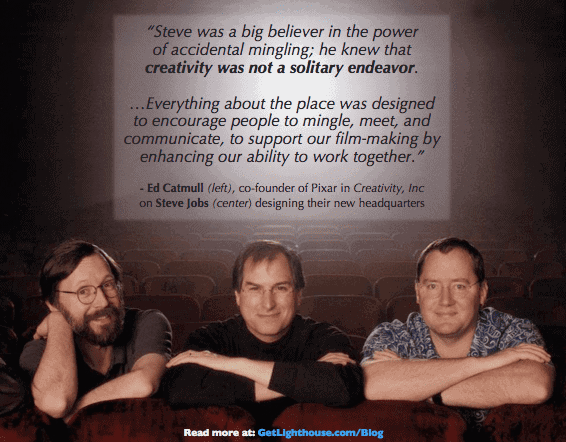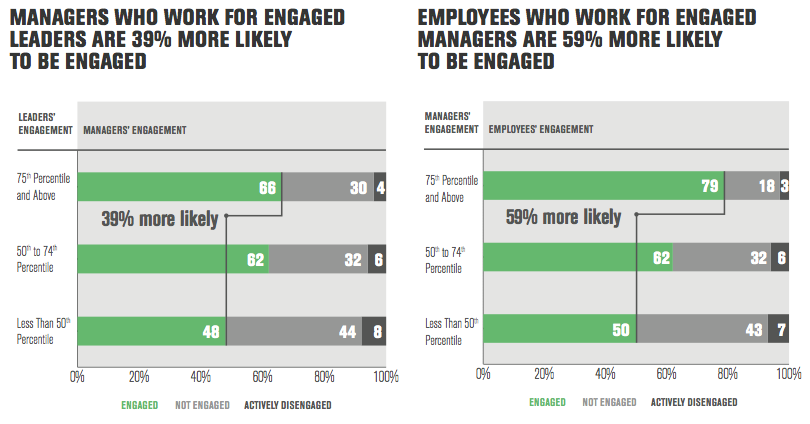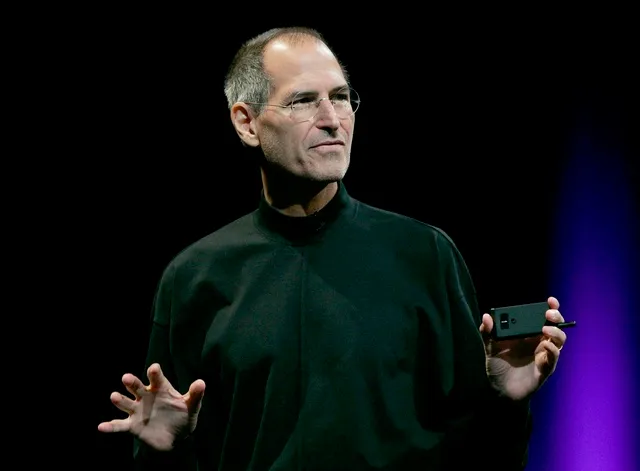What words come to mind when you think of Steve Jobs?
“Brilliant”, “great design”, “legendary” all may be positives that come to mind.
But he also had other not so great words tied to him like “authoritarian”, “a jerk”, “obnoxious”, and “unreasonable.”
The mythos of Steve Jobs's leadership style is complicated, especially if you are familiar with his strange, and many times ugly, behavior in his first stint at Apple.
However, he triumphantly returned. And when he did he was a different person.
And the changes he underwent transformed a near-failing company to one of the largest and most beloved companies.
Be careful lionizing your heroes.
The truth is that most leaders are more complicated and nuanced than the headline or glowing biography lets on. We all have dark sides and downsides to our personas, skills, and approaches to work.
That’s why it’s important to look at our heroes with clear eyes.
Rather than treating them either as a flawless ideal, or an excommunicated heathen, we should acknowledge their shortcomings and study their strengths. In doing so, you can learn both what you should emulate from their actions and behaviors, as well as the flaws you should avoid.
Today, we look at 5 unconventional yet valuable lessons related to Steve Jobs leadership qualities. You will learn the behaviors worth emulating, without having to practice his less desirable skills. These are the real leadership lessons of Steve Jobs that can help you succeed.
Lessons from Steve Jobs as a Leader:
- 1) Accept Feedback Gracefully, Even When It’s Delivered in a Hostile Way
- 2) Spur Innovation by Creating Collisions
- 3) Be Intentional in How You Handle Decision Making
- 4) Listen to Your Heart
- 5) Excellence is About Consistency
Steve Jobs's Leadership Style #1: Accept Feedback Gracefully, Even When It’s Delivered in a Hostile Way
Apple lost $1 billion in 1997.
— Jon Erlichman (@JonErlichman) June 10, 2024
Steve Jobs returned to the company and spoke to developers at WWDC.
When an attendee insulted him, he said:
“One of the hardest things when you’re trying to effect change is that people like this gentleman are right.”pic.twitter.com/XT5Daphshh
One of the hardest things to do as a leader is to take the ego hit of someone calling out a way you, your team, or company is wrong.
And what makes it even harder is when they do it in a not so nice way. What you see here in how Steve handles it is a great leadership lesson.
Here's a quick transcript of it, which is one of my favorite Steve Jobs quotes on leadership:
"One of the hardest things when you're trying to affect change is that people like this gentleman are right in some areas.
…The hardest thing is how does that fit in to a cohesive, larger vision that's going to allow you to sell $8 billion, $10 billion a product a year? And one of the things I've always found is that you've got to start with the customer experience and work backwards to the technology.
You can't start with the technology and try to figure out where you're going to try to sell it.
And I've made this mistake probably more than anybody else in this room.
And I've got the scar tissue to prove it.
…as we have tried to come up with a strategy and a vision for Apple, it started with what incredible benefits can we give to the customer? Where can we take the customer?
Not starting with let's sit down with the engineers and figure out what awesome technology we have and then how are we going to market that. And I think that's the right path to take."
As a product manager by trade, there's a lot to love in Steve Jobs's leadership quotes. Focusing on the customer is definitely the path to building great products that win markets.
However, the more important lesson for today is this: Be gracious when people give you feedback.
Be Gracious when you receive feedback
The first thing Steve did was admit the attendee was right. With how harsh the guy was, he didn't have to, but it immediately took the tension out of the room when he said,
“One of the hardest things when you're trying to affect change is that people like this gentleman are right in some areas."
He then reinforced it when he later said,
"And I've made this mistake probably more than anybody else in this room. And I've got the scar tissue to prove it."
This takes a great deal of humility to pull off. And when you think of Steve Jobs’s reputation, you’d have expected him to potentially blow up on the person like he sometimes did with employees.
Can you accept harsh feedback?
The skill that Jobs demonstrates is an advanced one. Your ego, emotions, and subconscious can make it extremely difficult to hear the feedback amidst the attack and sharp words of such a message.
Yet, being willing to listen and hear the kernel of truth within tough comments is the kind of skill that can take your leadership to a whole new level; it frees you to hear feedback in all its form, so you can take away the valuable parts, even when there's sharpness around it.
And this applies well beyond hostile crowds at public events.
As the former CFO of Shopify suggests, another place to seek out this kind of feedback is with new hires:
Ask your new hire to tell you everything that is wrong with your company.
— Mark MacLeod (@markmacleod_) April 29, 2024
They will only ever have fresh, outside eyes at the start.
Next time you hire someone, get them to rip your company to shreds.
You will learn a lot.
As MacLeod explains, you will learn a ton in doing so, but only if you make it easy to give feedback.
And making it easy isn’t just about asking for it frequently, or even listening well. It means accepting it in all its forms, including when it’s inconvenient timing, worded poorly, or feels like an attack on you.
I won’t pretend that’s easy to do in practice, but as you can see with how Jobs skillfully handled it, you can win over a crowd and make a big impact by learning to lead this way.
Further Reading:
If you need to get better at getting feedback, and accepting it no matter the form it comes in, start here:
- Learn how you can get more feedback from your team here.
- Make any ego bruises and harsh feedback easier to receive by working on your own positivity and positive frame of reference
- Practice mindfulness at work to stay aware of opportunities for feedback and be prepared for hard feedback.

Steve Jobs Leadership Qualities #2: Spur Innovation by Creating Collisions
While Steve Jobs passed away before COVID hit and so many of us shifted to remote working, I’m pretty sure he would have hated it.
Or maybe he would have invented a way to solve the challenges of working remotely.
Either way, Jobs loved something very important to creativity and great collaboration that is very office driven: collisions.
Collisions: Serendipity among your team
Ed Catmull, co-founder and president of Pixar Animation Studios, shares in his book, Creativity, Inc., a story about Steve Jobs and collisions. (Note: Jobs funded Pixar for nearly a decade while they developed their technology that ultimately led to their runaway hit, Toy Story.)
Jobs had strong opinions on the importance of these collisions to the point he took the lead on designing Pixar's building:

In the book, they talk about how the Pixar headquarters was a true passion project of Jobs. He obsessed over all the ways that he could create collisions.
One of the more famous ones was putting all the bathrooms in one area, so that people would run into each other heading to the bathroom. As you might imagine, this was slightly less popular with pregnant team members who did not enjoy the long walks many times per day, but overall it had the desired effect.
While animators had quiet offices to focus and do work, the rest of the building ensured that when they weren’t deeply focused, they could connect with others. This helped them solve problems, ideate, and collaborate with each other.
Create your own collisions on your team
One of the best things you can do as a leader is help your team build bonds and work better together. A team that enjoys each other's company and cares about each other will always crush the team that hates each other, no matter how good the skills of everyone is individually on the latter team.
And a key part of building those relationships, and reaping the benefits, is making sure you have collisions for them to repeatedly, serendipitously interact.
Try a few of these things:
-> Plan occasional events to help foster work friendships:
Team lunches, post work social outings, fun events during a work/team retreat, and hackathons are all ways that people can build friendships at work and get more comfortable interacting with each other.
If you're not sure which to do, try asking your team; what they'd enjoy doing may be different than other teams, and that's okay. The key is to do something people want to join in for.
-> Help create collisions:
"Collisions" help breed innovation as people share ideas and learn what other people are up to, help solve problems, and unintentionally connect.
If you're in an office at least some days each week, make sure your team sit near each other and are in on the same days. This maximizes the odds of collisions.
You can also check people’s schedules to make sure they have time in between any meetings where collisions are more likely to happen and won’t be stopped because a meeting has to start.
If you're all remote, consider how often you can bring people together in person so you get the real thing.
In the meantime and when you're not all together, encourage more small talk and intentional connections even if you need to budget it into your meetings. (More detailed advice in #4 here). You can also encourage people to have peer 1 on 1s, which are a great way to collide with people in complimentary roles.
-> Lead the way creating rapport and psychological safety:
Nothing is more powerful than the example you set. No, you aren't trying to be friends with your direct reports (that creates other problems), but in showing an interest in them as unique humans, and creating psychological safety, you create an environment for everyone else to get to know each other and take an interest in one another.
People who genuinely enjoy each other’s company and are comfortable frequently interacting are going to be a lot more likely to engage with their peer they run into randomly in the hallway or chat after a meeting. That comfort is key for how collisions work and as a leader you can help create the environment for them to happen more often.
Steve Jobs Leadership Traits #3: Be Intentional in How You Handle Decision Making
Steve Jobs on how to resolve conflict.pic.twitter.com/4GLhr8WkOf
— Jon Erlichman (@JonErlichman) April 18, 2024
This is a really fascinating, and nuanced comment by Steve Jobs.
Sometimes you should follow timeless rules. Other times, it's best to do something completely different, or even counter to the norm.
But you only get to that point by understanding the nuance of a situation, which is exactly what Jobs is doing here.
So let's take a closer look at what he's saying about decision making...
1) Don't always "disagree and commit."
One of the most common management phrases you'll hear is that good teams should "disagree and commit."
Like most management rules, there is some truth to it. And there is a time and a place for that, especially if your team gets to the point of having a religious debate over which framework to build an application in, or some other fundamental disagreement that turns more emotional than rational.
Yet, Jobs here is talking about something much deeper here.
For mission critical, big decisions, you need everyone to agree.
Why? A few reasons:
- Big decisions need full buy-in: You can't have someone halfway in, or begrudgingly support a decision, if it's literally core to your team or company's direction. You need everyone all-in.
- You should really understand opposition: Disagreement is your friend, especially on tough decisions. Learning why someone disagrees can help make your ideas stronger by identifying weaknesses, blind spots, and risks.
- Healthy cultures include diverse perspectives: Zooming out from a single disagreement, if you want to foster a culture where diverse perspectives are welcome, you have to actually listen to them.
As Jobs describes, sometimes you need to, "get everybody in a room and talk it through until you agree."
Can you imagine Apple building their amazing products with people reluctantly disagreeing but committing?
They would never have been able to, both because you can’t do your best work begrudgingly, and because these hard debates make their decisions better. They’re stronger for the debate, and you can be, too.
Welcome disagreement by working to understand concerns and resistance. Use that to make your ideas better by addressing those concerns. You may be surprised what that can do for bringing people into agreement.
2) Know which decisions are important
A key part of the nuance of what Jobs is talking about is that you need to be open to these kinds of discussions for your most important decisions.
No, you don't need to follow this approach when debating where to go for a team lunch. However, you should consider this approach when you and your team are determining your strategy for the second half of this year.
And that's why Jobs also talks about only making a small number of these decisions per year:
The most interesting aspects of this clip is Jobs’ claim that his executive team had 25 “really important” decisions to make in *a year*, suggesting that 1) they picked those decisions carefully, 2) they gave each one ample time and space, and 3) they delegated *everything else*. https://t.co/ezBD98SHDN
— Ed Batista (@edbatista) April 19, 2024
If this process is for 25 decisions per year, that's only ~2 per month.
That gives you plenty of time to let some tough debates happen, without exhausting people, especially because I think it's fair to assume some decisions won't have stiff disagreement.
Yet, when you do have disagreements, you want to have a process in place, and the will / energy to see it through.
You need to choose your battles, but also not be afraid to have them on the right topics.
3) Involve the right people in every decision
The last lesson that is just as important as the other two is making sure decisions are in the hands of the right people.
The true value of having this type of conflict and lively debate comes from the people disagreeing bringing relevant perspective, expertise, and experience related to the decision.
That means to apply this rule you should first make sure the decision is assigned to the team with the best skills, experience, and expertise to make the call.
One way Jobs handle this was with his “Product Cauldron” meetings. These were small groups that met to debate the most important product decisions.
As someone who worked with Jobs at Apple and NeXT described them:
“When I worked with Steve on product design, there was kind of an approach we took, unconsciously, which I characterize in my mind as a "cauldron".
There might be 3 or 4 or even 10 of us in the room, looking at, say, an iteration of iPhoto. Ideas would come forth, suggestions, observations, whatever. We would "throw them into the cauldron", and stir it, and soon nobody remembered exactly whose ideas were which. This let us make a great soup, a great potion, without worrying about who had what idea.
This was critically important, in retrospect, to decouple the CEO from the ideas. If an idea was good, we'd all eventually agree on it, and if it was bad, it just kind of sank to the bottom of the pot. We didn't really remember whose ideas were which -- it just didn't matter”
Fostering that kind of healthy discussion and debate doesn’t happen by accident. It comes from the leader leaving their title at the door. It comes from you allowing the best idea, not necessarily your idea to win.
And if you feel like the right team has a gap in their skills or perspective that would be valuable for the discussion and decision, then one of the best things you can do as a leader is to add to the team to fill in those gaps.
Sometimes leadership is less about your ideas, and more about who you bring together to arrive at the best ideas. This is a perfect example of that, and a reminder that the best teams challenge each other. There is no room for Yes Men and Yes Women in great cultures.
4) Listen To Your Heart
Leadership is not about turning yourself into a robot. While there are some sobering moments where you might feel a bit cold and calculating, that’s far from how you should be all the time.
Steve Jobs’s commencement speech from 2005 is filled with great life lessons that apply to anyone, but especially for leaders trying to chart their life course. It's filled with some of the best Steve Jobs quotes on leadership you'll find anywhere, so I encourage you to listen to the whole thing
However, today I want to share two of my favorite lessons in particular that are related to his leadership style:
1. It's okay to take detours.
"...looking back it was one of the best decisions I ever made. The minute I dropped out I could stop taking the required classes that didn’t interest me, and begin dropping in on the ones that looked interesting...much of what I stumbled into by following my curiosity and intuition turned out to be priceless later on."
Famously, Steve Jobs dropped out of college. He was one of the first in what is a historic line of well-known tech founders who dropped out of school.
Yet, unlike most of the other dropouts, Steve kept going to classes.
Which as fate would have it led him to take a calligraphy class, which came in handy when they were designing fonts and the user experience on the then revolutionary Macintosh computer:

As Steve put it, "If I had never dropped in on that single course in college, the Mac would have never had multiple typefaces or proportionally spaced fonts."
Make time for some passion and interests.
For all the talk about being efficient, getting things done, and thinking strategically, it can be easy to forget to follow your heart.
Even if you're mid or late in your career, keep your interests and hobbies going. Learning things you're interested in can lead to all kinds of exciting opportunities you can't foresee.
Remember: Steve took that class, and then didn't use his knowledge of fonts from his calligraphy class until 10 years later.
What passion do you have that you're not giving some of your time and attention?
You never know where it might pay off, but I've seen examples personally like:
- A friend found their next job because of the obscure interest they had that was shared by the executive that recruited them.
- A CTO learned about new technology based on the interesting work they'd done on a side project, which they then used on a key work project.
- A teammate on an old soccer team found that the same people that played soccer at a high level were often great sources for recruiting.
You may be surprised how many great friends you can make when you cultivate your interests, even if just a few hours a month.
And you don't have to change jobs either; often side projects and hobbies can be just as valuable building rapport with your current peers or bringing fresh ideas to the company you already enjoy working at.
2. Do the work you LOVE.
"Sometimes life hits you in the head with a brick. Don’t lose faith. I’m convinced that the only thing that kept me going was that I loved what I did.
You’ve got to find what you love....Your work is going to fill a large part of your life, and the only way to be truly satisfied is to do what you believe is great work. And the only way to do great work is to love what you do.
If you haven’t found it yet, keep looking. Don’t settle. "
If there's one thing Jobs is known for, I think it would be his passion. His enthusiasm for the products he helped create is legendary. The way people hung on his every word at Apple launch events is a testament to this.
Yet, even he challenged himself to stick to that principle as he remarked:
"For the past 33 years, I have looked in the mirror every morning and asked myself: “If today were the last day of my life, would I want to do what I am about to do today?” And whenever the answer has been “No” for too many days in a row, I know I need to change something."
You can see this in how Jobs shifted his focus over the years to various projects and products that ignited his passion. But he never let them take him over completely, which allowed him to move from one innovation to the next, seemingly always at just the right time.
This seems particularly relevant when he stopped focusing on the iPod and started trying to make the iPhone a reality. And this shift happened just as the technology to make the iPhone a reality was just barely becoming available (and sometimes Apple had to invent it!)
Bring the mindset of a craftsman to your work
You don't have to be the CEO of a massive company like Jobs to do what you love. We can all be craftsmen and craftswomen, deeply proud of our work.
That's why it's important to take stock as Steve did asking if you want to be doing what you're doing today.
If the answer is no, start working on your exit plan. Life is too short to drag yourself through a job, especially as a leader.
Remember: How you feel is passed on to your team. They deserve a manager happy to be there, too.
Otherwise, you run into what Gallup calls “the Cascade Effect” where your disengagement causes your team to disengage, too:

Jobs put it best when he said:
"Your time is limited, so don’t waste it living someone else’s life. Don’t be trapped by dogma — which is living with the results of other people’s thinking. Don’t let the noise of others’ opinions drown out your own inner voice.
And most important, have the courage to follow your heart and intuition. They somehow already know what you truly want to become. Everything else is secondary."
And this should also apply to your team. If you see a team member who clearly hates it at your company or is miscast in their role, help them find a better one, whether at your company or another.
The karma you'll get for helping them will pay you back many times over, and your team will be better for it, too.
Further Reading:
Looking to reignite your passions or decide if your current job is not where you want to be anymore? Start here:
- Even as a manager or senior leader you need to take breaks.
- If you think it might be time to move on from a job, learn how to quit the right way.

Steve Jobs's Leadership Style #5: Excellence is about consistency
Many of us remember Steve Jobs for his demanding and autocratic leadership style. It’s a trait so famous that it became a core part of his character in the movie versions of his life.
While some viewed his approach as harsh and dictatorial, others recognized it as a key driver behind Apple's innovative breakthroughs and successfully building best in class products. Let's take a look at the nuance of this.
Focus creates the environment for excellence.
Jobs famously said, "Be a yardstick of quality. Some people aren’t used to an environment where excellence is expected."
To accomplish this, when he returned to Apple in 1997, Jobs immediately streamlined the company's product lines, deciding to focus on four key products without extensive consultation. He axed all the other projects so they could focus exclusively on those handful of products.
This was a common pattern in his leadership style. He made bold decisions and then focused everyone's efforts on delivering excellence in those key areas. As Jobs put it, "Innovation distinguishes between a leader and a follower," which is exactly what Apple became under this philosophy.
Set the bar HIGH.
Once you focus your team on key objectives, the real work begins. It's not enough to be focused, now you have to deliver.
And Jobs and Apples did that in spades, because one of the legendary Steve Jobs leadership traits is his obsession with the details.
As an example of how much detail Jobs cared about, he called the VP of Engineering at Google on a Sunday to tell them there was a problem with Google's logo and how it displayed on the iPhone. Jobs told the VP:
“I’ve been looking at the Google logo on the iPhone and I’m not happy with the icon.
The second O in Google doesn't have the right yellow gradient. It's just wrong and I'm going to have Greg fix it tomorrow. Is that OK with you?”
When you set an example of the work you will not accept, and help get changed promptly, you show your team what excellence looks like to you. It demonstrates you care and you're willing to do something about it.
If you do this a few times, you will absolutely see changes in your team, because if they respect you, they'll start reviewing their own work to make sure it meets the standard you're setting.
Push for some unreasonable goals.
You don't know what you can achieve until you challenge yourself. Jobs was notorious for pushing his teams to do more and in less time than they imagined. This is a key reason why many people have said they did the best work of their lives while working at Apple.
You can see this in particular with the development of the iPhone:
- Jobs was obsessed with every little detail, including the keyboard and how it felt.
- In just 3 years, "Project Purple" went from an idea to one of the most impressive launches in tech history.
- In 2005, two years before the iPhone would launch to the world, he gave his engineers on the team just two weeks to come up with their vision for the software on the phone.
- He reviewed their work every two weeks throughout the project to help test new features and push the team to continue at a hard pace.
All of this effort, and pushing aggressively paid off. The market and customers were wowed by how much the iPhone could do compared to phones then on the market. This Reddit thread captures the excitement and surprise well.
A caveat: Know your team's limits and do your part.
It's important to recognize why this worked for Jobs. He worked as hard as anyone on the team, and he wasn't afraid to roll up his sleeves and help identify and fix issues. He proposed solutions just as much as he pointed out problems or declared deadlines.
I cannot stress enough how important that is to making this work.
If you give your team an impossible deadline, causing them to work nights and weekends, and they see you leaving at 5:01pm every day, you're going to create a lot of resentment. Equally important, being involved in ways that you're effective and helpful can show that you're in it together.
It is inspiring and motivating to see your boss helping out, even if it's simply to wash the coffee mugs, or help test a feature in QA for the 100th time.
If you want to push your team to excellence, make sure you do your part.

Final Word: The real leadership lessons of Steve Jobs show a complex leader worthy of study
Like many famous leaders, Steve Jobs was a complicated man. There are some parts of his life and personality no one should emulate (i.e.- his weird diets, neglecting and denying his daughter, and refusing to give equity to employees before their IPO).
Yet, we should be careful not to throw the baby out with the bathwater.
Just because someone was a flawed human, does not mean we cannot learn from them.
That’s why despite his shortcomings, it’s worth recognizing the great leadership traits Steve Jobs displayed. We can learn a lot from them.
In the end, every leader is different, and your own journey as a leader is unique. That’s why it’s important to study other leaders; doing so helps you see pitfalls you should avoid, and ideas or behaviors that resonate with you that you should add to your own leadership style.
You become the best version of yourself when you add the best of other people to your own leadership style and way of being.
Which of Steve Jobs's leadership traits will you add to your leadership style? Which will you avoid?




